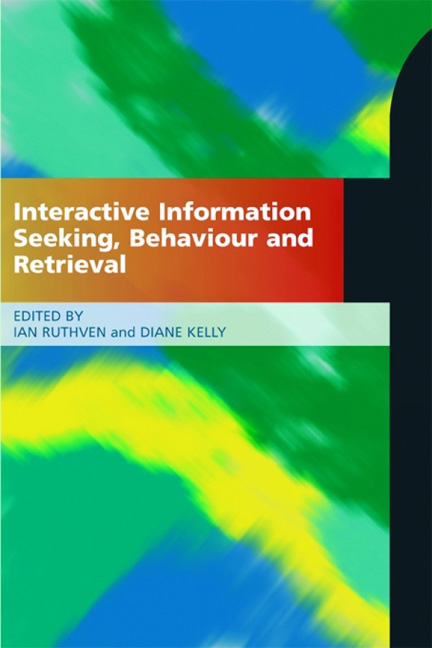Book contents
- Frontmatter
- Dedication
- Contents
- Figures and tables: acknowledgements
- Contributors
- Foreword
- Preface
- 1 Interactive information retrieval: history and background
- 2 Information behavior and seeking
- 3 Task-based information searching and retrieval
- 4 Approaches to investigating information interaction and behaviour
- 5 Information representation
- 6 Access models
- 7 Evaluation
- 8 Interfaces for information retrieval
- 9 Interactive techniques
- 10 Web retrieval, ranking and personalization
- 11 Recommendation, collaboration and social search
- 12 Multimedia: behaviour, interfaces and interaction
- 13 Multimedia: information representation and access
- References
- Index
Foreword
Published online by Cambridge University Press: 08 June 2018
- Frontmatter
- Dedication
- Contents
- Figures and tables: acknowledgements
- Contributors
- Foreword
- Preface
- 1 Interactive information retrieval: history and background
- 2 Information behavior and seeking
- 3 Task-based information searching and retrieval
- 4 Approaches to investigating information interaction and behaviour
- 5 Information representation
- 6 Access models
- 7 Evaluation
- 8 Interfaces for information retrieval
- 9 Interactive techniques
- 10 Web retrieval, ranking and personalization
- 11 Recommendation, collaboration and social search
- 12 Multimedia: behaviour, interfaces and interaction
- 13 Multimedia: information representation and access
- References
- Index
Summary
The job of the search user interface is to aid users in the expression of their information needs, in the formulation of their queries, in the understanding of their search results, and in keeping track of the progress of their information seeking efforts.
(Marti Hearst, Search User Interfaces, Cambridge University Press, 2009)Search user interfaces are at the centre of interactive information seeking and retrieval. Yes, search user interfaces include the jobs that the quotation above enumerates and even more. While this book is not only about interfaces, it is also about those jobs and even more about that more.
This book reports on the recent advances on interaction topics reflected in its title. However, the historic roots of these topics go deep – and like all roots they are entangled and not that visible. But we can learn from them in terms of problems addressed and solutions attempted. Research on information-seeking behaviour, under various names and orientations, goes back many decades. So let us start with a bit of general history of the topics covered by the book; more specific history is presented in Chapter 1.
Activities associated with what we now call information retrieval existed and were practised long before Calvin Mooers (1919–1994, physicist and information retrieval pioneer) coined the term information retrieval in 1951. They were rooted in libraries but left them to become part of technology.
Mooers (1951) defined information retrieval as follows:
Information retrieval is … the finding or discovery process with respect to stored information … useful to [a user]. Information retrieval embraces the intellectual aspects of the description of information and its specification for search, and also whatever systems, techniques, or machines that are employed to carry out the operation.
Not surprisingly, interaction is not mentioned in this definition – at the time the concept and term (in its present denotation and connotation) did not exist, even though interaction was practised from the start using ‘whatever systems, techniques, or machines’ were available. Even ‘intellectual aspects … for search’ imply interaction. As it turned out, the ‘systems, techniques or machines’ on the one hand and ‘intellectual aspects’ on the other became two major branches of problem orientation and inspiration for information retrieval research and practice.
- Type
- Chapter
- Information
- Interactive Information Seeking, Behaviour and Retrieval , pp. xxv - xxxiiPublisher: FacetPrint publication year: 2011



